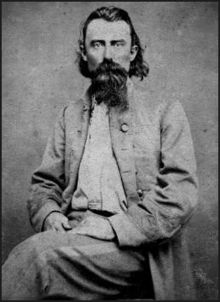
One of the main figures of the Battle of Glasgow was not present during the battle, although he certainly had visited the city in happier times. GEN Stirling Price was the commander who sent part of his forces to attack the city.
Price had been born in Virginia, where he attended college and later established a law practice. He later moved his family to Fayette, MO and then to Keytesville, MO where he operated a hotel and store. He was also a slave owner and a tobacco farmer. He served as a Federal General in the Mexican-American war. He commanded the US forces in the last battle of the Mexican-American War. In fact, it was fought AFTER the war was officially over. He defeated a Mexican force, which outnumbered him 3 to 1. He was reprimanded by the Secretary of War for engaging in this battle. However, he was honorably discharged in 1848 and went home to Missouri as a hero. Partially because of his popularity, he was easily elected as the 11th Governor of the state of Missouri in 1852.
During Price’s term of office as Governor of Missouri a number of advances were accomplished in the state. Washington University was established, the Missouri State Teacher’s Association was formed, the state’s educational system was reformed, the railroad network was expanded, and a state geological survey was completed. The legislature passed a bill to increase the Governor’s salary, but Price refused to accept more money than the amount in force at the time of his election. After his service as Governor, he became the State Banking Commissioner.
The ladies of Glasgow made a large US flag that they presented to then Union General Price. After his resignation of his Federal commission and his acceptance of a commission in the pro-confederacy Missouri Militia, he returned the flag to the city. It hangs now in the upstairs of Glasgow’s Lewis Library.
Price was elected presiding officer of the Missouri State Convention in 1861 and he voted against secession. However, when Union General Lyon seized control of the State Militia Camp in St. Louis, Price was outraged and was appointed by pro-southern Governor Claiborne Fox as the commander of the Missouri Militia.
His young soldiers were very fond of their General, whom they nicknamed "Old Pap". He won battles at Lexington and Wilson’s Creek. In 1862, he was commissioned as a Major General of the Confederate Army. Prior to that time, he was a member of the Missouri Militia and not a regular officer of the Confederacy. Price’s troops were defeated in battles at Corinth, Mississippi and Pea Ridge, Arkansas.
Price wanted to fight in Missouri and had a personal meeting with Confederate President Jefferson Davis to seek permission. Davis questioned Price’s loyalty and described him as " the vainest man I ever met". Still, he did grant permission for Price to move into Missouri.
Price began his Missouri campaign with 12,000 horsemen and 14 pieces of artillery. His first Missouri Battle was at Pilot Knob. He won that battle, but lost many men in the action. Price fount several other battles as he moved toward Jefferson City. He elected to bypass Jefferson City because he felt it was too heavily defended. As he moved toward his next objective at Westport (Kansas City), he lost more men to small battles, sickness, and desertion.
When Price learned that weapons and supplies were at Glasgow, MO, he dispatched Generals John Clark and Joe Shelby to attack Glasgow and to seize those valuable materials. (See Order of Battle Article). This reduced Price’s forces by about 1800 men and several competent officers. 

Price was defeated at Westport two weeks after the Battle of Glasgow and decided to retreat back to Arkansas. During his move south, he was attacked by Union forces and suffered more losses. Although, the Glasgow Battle was a Confederate victory and some supplies were seized, it was not enough to make the Missouri Raid a military success.
When the war ended, Price refused to surrender and took many of his troops with him to Mexico. He later became the leader of a Confederate colony in Veracruz. When that colony failed, he returned to Missouri.
While in Mexico, Price developed intestinal problems and typhoid fever. At the end of his life in St. Louis, he was in poor health and impoverished. He died in 1867 of cholera. His death certificate lists the cause of death as "chronic diarrhea".
Price’s funeral was held on 3 OCT 1867 at the First Methodist Episcopal Church on the corner of Eighth and Washington in St. Louis. His funeral procession was the largest held in St. Louis up to that time. He is buried in Bellefontaine Cemetery in St. Louis.
Photos TOP General Stirling Price LEFT General John B. Clark RIGHT General Joe Shelby
Return to main page Click Here
Site last updated 26 OCT 2021. © 2014